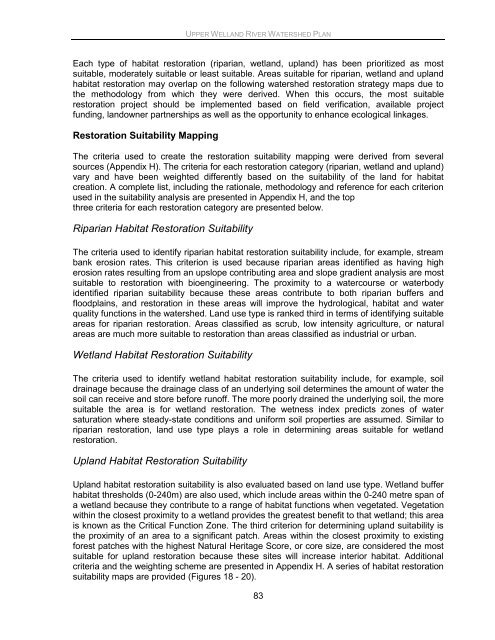Upper Welland River Watershed Plan - Niagara Peninsula ...
Upper Welland River Watershed Plan - Niagara Peninsula ...
Upper Welland River Watershed Plan - Niagara Peninsula ...
You also want an ePaper? Increase the reach of your titles
YUMPU automatically turns print PDFs into web optimized ePapers that Google loves.
UPPER WELLAND RIVER WATERSHED PLANEach type of habitat restoration (riparian, wetland, upland) has been prioritized as mostsuitable, moderately suitable or least suitable. Areas suitable for riparian, wetland and uplandhabitat restoration may overlap on the following watershed restoration strategy maps due tothe methodology from which they were derived. When this occurs, the most suitablerestoration project should be implemented based on field verification, available projectfunding, landowner partnerships as well as the opportunity to enhance ecological linkages.Restoration Suitability MappingThe criteria used to create the restoration suitability mapping were derived from severalsources (Appendix H). The criteria for each restoration category (riparian, wetland and upland)vary and have been weighted differently based on the suitability of the land for habitatcreation. A complete list, including the rationale, methodology and reference for each criterionused in the suitability analysis are presented in Appendix H, and the topthree criteria for each restoration category are presented below.Riparian Habitat Restoration SuitabilityThe criteria used to identify riparian habitat restoration suitability include, for example, streambank erosion rates. This criterion is used because riparian areas identified as having higherosion rates resulting from an upslope contributing area and slope gradient analysis are mostsuitable to restoration with bioengineering. The proximity to a watercourse or waterbodyidentified riparian suitability because these areas contribute to both riparian buffers andfloodplains, and restoration in these areas will improve the hydrological, habitat and waterquality functions in the watershed. Land use type is ranked third in terms of identifying suitableareas for riparian restoration. Areas classified as scrub, low intensity agriculture, or naturalareas are much more suitable to restoration than areas classified as industrial or urban.Wetland Habitat Restoration SuitabilityThe criteria used to identify wetland habitat restoration suitability include, for example, soildrainage because the drainage class of an underlying soil determines the amount of water thesoil can receive and store before runoff. The more poorly drained the underlying soil, the moresuitable the area is for wetland restoration. The wetness index predicts zones of watersaturation where steady-state conditions and uniform soil properties are assumed. Similar toriparian restoration, land use type plays a role in determining areas suitable for wetlandrestoration.Upland Habitat Restoration SuitabilityUpland habitat restoration suitability is also evaluated based on land use type. Wetland bufferhabitat thresholds (0-240m) are also used, which include areas within the 0-240 metre span ofa wetland because they contribute to a range of habitat functions when vegetated. Vegetationwithin the closest proximity to a wetland provides the greatest benefit to that wetland; this areais known as the Critical Function Zone. The third criterion for determining upland suitability isthe proximity of an area to a significant patch. Areas within the closest proximity to existingforest patches with the highest Natural Heritage Score, or core size, are considered the mostsuitable for upland restoration because these sites will increase interior habitat. Additionalcriteria and the weighting scheme are presented in Appendix H. A series of habitat restorationsuitability maps are provided (Figures 18 - 20).83
















